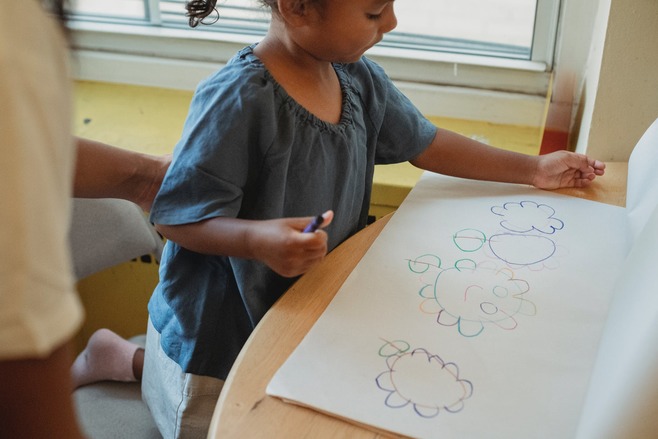Every kid has the innate ability to be creative, but not every kid has the innate ability to express that creativity. Parents often think that children are naturally either good at drawing or not, but this isn’t true.
You wouldn’t put your kid in front of a piano and expect them to play a beautiful piece of music. They might have fun tapping on the notes but they won’t be able to play anything without learning the basics first. The same goes for drawing. Kids need to learn the basics and technicalities before creating art that’s meaningful to them.
When kids don’t understand the basics, art can get frustrating to them. They might think that they’re just not cut out for it, but they are.
Parents should treat art like they treat math and reading. Teaching kids to draw is essential in helping them develop. It’s a valuable life skill that provides kids with a creative outlet and a hobby they might end up loving. It’s important to teach kids drawing now more than ever—As schools are lessening art time in class and ending art programs entirely.
Today we’re going to go over how to teach kids to draw and inspire creativity.
The Benefits of Drawing
There are plenty of reasons why you should teach your kids to draw.
Let’s go over some of the major ones:
It makes kids smarter
A study from Germany suggests that drawing activates and exercises certain key parts of the brain. Participants had their brains scanned using fMRI technology, and went through several intelligence tests. These tests measured how active their brains were when it came to memory recall, problem-solving, and math skills.

The subjects attended a weekly two-hour class in which they learned technical art skills followed by having the chance to make their own art. The brain scans at the end of the experiment found improvement “within the brain’s default mode network, which is associated with cognitive processes such as introspection, self-monitoring, and memory”.
Another study proves that students who had some form of art education did better in school. Specifically in math and communication. These students were also less likely to get expelled and more likely to pursue a degree.
It just makes sense, too. Most people are visual learners, so kids would be able to relate school subjects to art.
It’s good for the heart and mind
A 2011 study shows how drawing reduces stress and alleviates anxiety. While kids aren’t going through the trouble of paying bills, they still might get a bit stressed from homework or school material. Drawing gives them an early and healthy outlet to relieve stress.
Another study shows how making art can make people happier. It provides a sense of belonging and purpose. Also, it’s just really satisfying to see your ideas come to fruition.

Art can bring kids together. Your child might want to draw with others at school or talk about their artwork during recess. Giving your child access to drawing lets them have fun with a community full of little artists.
Now let’s get into how you can teach kids to draw.
1. Encourage Doodling
Doodling is the act of holding a pencil and letting it guide your hand around the page. We all seem to do this sometimes. When we’re working on something and we make little marks in the margins—that’s doodling.
Kids love to doodle, they seem to do it all the time. At home, on restaurant menus, at school, maybe even on the wall… oops!

Encourage doodling at home on paper. Any practice is good!
2. Make Space for Art
Try to get a little table in the corner of a room somewhere just for art. Don’t obsess over keeping this area clean (trust me, you can’t), just make sure it’s somewhere you can monitor. Leave all the art material your child could need here. Pencils, crayons, paper, and maybe a mini easel!
If you want to go the extra mile, provide a color wheel and a guide to drawing shapes and simple figures. Your child could reference these when creating artwork.
3. Teach the Basics
This part might get tricky. You never want to explicitly “tell” your child what to draw or how to do something. This might limit their creativity and bound them to your instructions.
However, it’s important to get the basics across. You want them to have the tools to express themselves. You can teach them basic shapes like circles, triangles, and rectangles. These basic shapes can take them a long way.
When they’re ready, start introducing them to concepts like proportion, balance, shading, and perspective. Don’t rush it, though! Everyone moves and develops at their own pace.
4. Practice!
Art is a journey. You can help by giving your kid some exercises and activities that’ll develop their skills.
\ There are many different ways to practice drawing.

You can ask them to draw something from their life. For example, their backpack or their shoes. Help them by finding references for them. This is called observational drawing, or “draw what you see”.
There’s also imaginative drawing, which is what most kids tend to do. This is when they draw something from their imagination (like a zombie princess or an animal castle). Kids love imaginative drawing, this is their creativity in its pure form.
5. Talk About Art
It’s important to discuss what’s going on in your child’s life, and the same applies to their art. Talking about art let them tell you what they’re thinking and feeling.
Have your child show you some of their art. Ask them about what they were trying to show and why. Better yet, compliment them. Try to make the compliments specific. For example, instead of saying “I like it”, say something like “I love how you put these colors so close together” or “The way that you made all these straight lines looks so pretty”.
You can hang up a few pieces of their favorite artwork. You can have them pick out their three favorite drawings and put them somewhere everyone can see. This is going to motivate them to draw more and make them feel good about themself and their work.

It’s important to never criticize when looking at their artwork. This might make them feel bad or like their ideas aren’t good enough.
Have Fun!
Art is about expression, creativity, community, and simply having fun.
Maybe your child doesn’t end up loving art, that’s completely okay. At least you know you tried it out and gave them that opportunity.
But if they end up loving art, then they’re going to have a passion for the rest of their life that they have you to thank for.
Happy drawing!